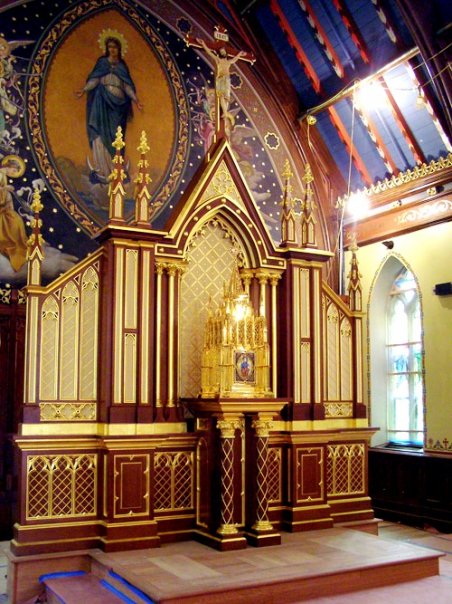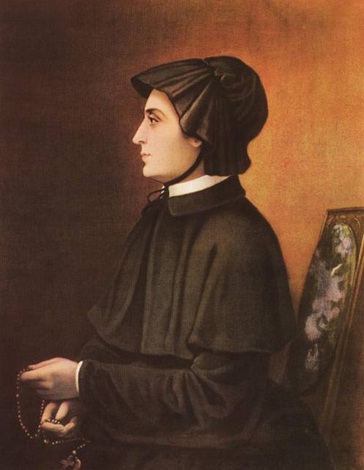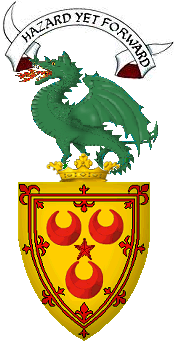|
Saint Elizabeth Ann Seton,
Mother Seton,
of Parbroath of New York
  Elizabeth
Ann was born on August 28, 1774 to Richard Bayley and Catherine
Charlton of New York City. She was raised in the Episcopal
Church. Her mother, daughter of an Episcopal priest, died when
Elizabeth was three. At the age of nineteen, she married William
Magee Seton of the Parbroath line, a wealthy businessman in the
import trade who's father the noted William Seton had emigrated
to New York in 1763, at the instigation of his brother-in-law
Andrew Seton of the Barnes Family. Elizabeth had five children
were born from her marriage: Anna Maria, William, Richard,
Catherine, and Rebecca. Elizabeth
Ann was born on August 28, 1774 to Richard Bayley and Catherine
Charlton of New York City. She was raised in the Episcopal
Church. Her mother, daughter of an Episcopal priest, died when
Elizabeth was three. At the age of nineteen, she married William
Magee Seton of the Parbroath line, a wealthy businessman in the
import trade who's father the noted William Seton had emigrated
to New York in 1763, at the instigation of his brother-in-law
Andrew Seton of the Barnes Family. Elizabeth had five children
were born from her marriage: Anna Maria, William, Richard,
Catherine, and Rebecca.
William Magee Seton married Elizabeth Ann Bayley in 1793,
although after the death of his father, William Seton Sr in 1798,
they assumed care for William's seven siblings and he assumed
control of the family Seton shipping business.
Elizabeth had always been busy with raising a large family and
the management of their home, yet she continued to show the
concern for the poor of the city which her father and stepmother
had taught her. She helped to organize a group of prominent
ladies who would visit the sick poor in their homes to render
what aid they could. This circle was informally called the
"Ladies of Charity" due to their conscious inspiration by the
work of St. Vincent de Paul in 17th century France.
Their home in
Manhattan, New York City, was located at the site on which a
church now stands in her honor, with the formerly matching
building at the right (7 State Street) forming part of the
shrine. By 1802, the effects of the blockade by the United
Kingdom for Napoleonic France, coupled with the loss of several
of her husband's ships at sea, led to his bankruptcy and soon
after this he fell ill and his doctors recommended sending him
to Italy for the warmer climate to recover, with Elizabeth and
their eldest daughter were to accompanying him.
Due to his own
ill-health he poorly managed the business, and it failed, and in
1803, due to a developing tuberculosis, he and Elizabeth went on
a voyage to Pisa, Italy where he had hoped that the mild and
beneficial air would be a remedy for his condition. They
landed at the port of Livorno, however, they were placed in
quarantine by the Italian Government for almost a month.
Later in Italy, they
became acquainted there with the Catholic Chevalier Philip Filicchi and his family, although
it was too late for William and he died two weeks after his
release from the effects of the quarantine, at
the Filicchi home in Pisa on Dec. 27th, 1803. He was buried in
the Cemetery at Leghorn, in a modest tomb next to Smollett's.
Elizabeth and Anna
Maria were taken-in by the family of her late husband's Italian
business partners, and while staying with them she was
introduced to Roman Catholicism. Two years later, after her
return to the United States, she converted to the Roman Church,
where she was received on March 14, 1805 by the pastor of St.
Peter's Church, the only Catholic church open in the city at
that time due to the recent lifting of anti-Catholic laws under
the new Republic. She was confirmed a year later by the only
bishop of the new nation, the first bishop of Baltimore, the
Right Reverend John Carroll.
It was after her return to New York, in order to support herself
and her children, that Mrs. Seton started an academy for young
ladies, as was common for widows of social standing in that
period. The news of her conversion to the Roman Church spread,
and most of the parents withdrew their daughters from her
tutelage due to the anti-Catholic sentiment of the day. By
chance, around this time she met a visiting priest, the Abbé
Louis Dubourg, S.S., who was a member of the French emigré
community of Sulpician Fathers. The priests had taken refuge in
the United States from the religious persecution of the Reign of
Terror in France, and were in the process of establishing the
first Catholic seminary for the United States, in keeping with
the goals of their Order. For several years, Dubourg had
envisioned a religious school to meet the educational needs of
the small Catholic community in the nation.
In 1809, after some trying and difficult years, Elizabeth
accepted the invitation of support the Sulpicians had made to
her and moved to Emmitsburg, Maryland. A year later she
established the Saint Joseph's Academy and Free School, a school
dedicated to the education of Catholic girls, due to the
financial support of Samuel Sutherland Cooper. He was a wealthy
convert and seminarian at the newly established Mount St. Mary's
College and Seminary, begun by the Abbé (later Bishop) John
Dubois, S.S., and the Sulpicians. In July of that year,
Elizabeth was able to establish a religious community in
Emmitsburg, Maryland dedicated to the care of the children of
the poor. It was the first congregation of Religious Sisters to
be founded in the United States, and its school was the first
free Catholic school in America. The order was initially called
the Sisters of Charity of St. Joseph. From that point on, she
became known as Mother Seton.
Mr. Cooper, a
Virginian convert and seminarian, offered $10,000 to found an
institution for teaching poor children. A farm was bought half a
mile from the village of Emmitsburg and two miles from Mt. St.
Mary's College. Meanwhile Cecilia Seton and her sister Harriet
came to Mrs. Seton in Baltimore. As a preliminary to the
formation of the new community, Mrs. Seton took vows privately
before Archbishop Carroll and her daughter Anna. In June, 1809,
the community was transferred to Emmitsburg to take charge of
the new institution. The great fervour and mortification of
Mother Seton, imitated by her sisters, made the many hardships
of their situation seem light. In Dec., 1809, Harriet Seton, who
was received into the Church at Emmitsburg, died there, and
Cecilia in Apr., 1810.
Bishop Flaget was commissioned in 1810 by the community to
obtain in France the rules of the Sisters of Charity of St.
Vincent de Paul. Three of these sisters were to be sent to train
the young community in the spirit of St. Vincent de Paul, but
Napoleon forbade them to leave France. The letter announcing
their coming is extant at Emmitsburg. The rule, however, with
some modifications, was approved by Archbishop Carroll in Jan.,
1812, and adopted.
Against her will, and despite the fact that she had also to care
for her children, Mrs. Seton was elected superior. The remainder
of her life was spent in leading and developing the new
congregation. Many joined the community; Mother Seton's
daughter, Anna, died during her novitiate (12 March, 1812), but
had been permitted to pronounce her vows on her death-bed.
Mother Seton and the eighteen sisters made their vows on 19
July, 1813. The fathers superior of the community were the
Sulpicians, Fathers Dubourg, David, and Dubois. Father Dubois
held the post for fifteen years and laboured to impress on the
community the spirit of St. Vincent's Sisters of Charity, forty
of whom he had had under his care in France. The fervour of the
community won admiration everywhere. The school for the
daughters of the well-to-do prospered, as it continues to do
(1912), and enabled the sisters to do much work among the poor.
In 1814 the sisters were given charge of an orphan asylum in
Philadelphia; in 1817 they were sent to New York. The previous
year (1816) Mother Seton's daughter, Rebecca, after long
suffering, died at Emmitsburg; her son Richard, who was placed
with the Filicchi firm in Italy, died a few years after his
mother. William, the eldest, joined the United States Navy and
died in 1868. The most distinguished of his children are Most.
Rev. Robert Seton, Archbishop of Heliopolis (author of a memoir
of his grandmother, "Roman Essays", and many contributions to
the "American Catholic Quarterly" and other reviews, and who
began the process of Beatification), and William Seton.
Mother Seton had great facility in writing. Besides the
translation of many ascetical French works (including the life
of Saint Vincent de Paul, and of Mlle. Le Gras) for her
community she has left copious diaries and correspondence that
show a soul all on fire with the love of God and zeal for souls.
Great spiritual desolation purified her soul during a great
portion of her religious life, but she cheerfully took the royal
road of the cross. For several years the saintly bishop (then
Father) Bruti was her director. The third time she was elected
mother (1819) she protested that it was the election of the
dead, but she lived for two years, suffering finally from a
pulmonary affection. Her perfect sincerity and great charm aided
her wonderfully in the work of sanctifying souls. In 1880
Cardinal Gibbons (then Archbishop) urged the steps be taken
toward her canonization. The result of the official inquiries in
the cause of Mother Seton, held in Baltimore during several
years, were brought to Rome by special messenger, and placed in
the hands of the postulator of the cause on 7 June, 1911.
Today, six separate
religious communities trace their roots to the beginnings of the
Sisters of Charity in Emmitsburg, Maryland. In addition to the
original community of Sisters at Emmitsburg (now part of the
Vincentian order), they are based in New York City; Cincinnati,
Ohio; Halifax, N.S.; Convent Station, New Jersey; and
Greensburg, Pennsylvania.
Her cause is entrusted to the Priests of the Congregation of the
Mission, whose superior general in Paris is also superior of the
Sisters of Charity with which the Emmitsburg community was
incorporated in 1850, after the withdrawal of the greater number
of the sisters (at the suggestion of Archbishop Hughes) of the
New York houses in 1846. This union had been contemplated for
some time, but the need of a stronger bond at Emmitsburg, shown
by the New York separation, hastened it. It was effected with
the loss of only the Cincinnati community of six sisters. With
the Newark and Halifax offshoots of the New York community and
the Greenburg foundation from Cincinnati, the sisters
originating from Mother Seton's foundation number (1911) about
6000. The original Emittsburg community now wearing the cornette
and observing the rule just as St. Vincent gave it, naturally
surpasses any of the others in number. It is found in about
thirty dioceses in the United States and forms a part of the
worldwide sisterhood, whilst the others are rather diocesan
communities.
Mother Seton was described as a charming and cultured lady. Her
connections to New York society and the accompanying social
pressures to leave the new life she had created for herself did
not deter her from embracing her religious vocation and
charitable mission. She established St. Joseph's Academy and
Free School in order to educate young girls to live by religious
values. The greatest difficulties she faced were actually
internal, stemming from misunderstandings, interpersonal
conflicts, and the deaths of two daughters, other loved ones,
and young Sisters in the community. She died herself of
tuberculosis, on January 4, 1821, at the age of 46.
Today, her remains are
entombed in the Basilica that bears her name: the Basilica of
the National Shrine of Saint Elizabeth Ann Seton.
On December 18, 1959,
Elizabeth was declared Venerable by the Sacred Congregation of
Rites of the Catholic Church. She was beatified by Pope John
XXIII on March 17, 1963, and canonized by Pope Paul VI on
September 14, 1975, making her the first native-born United
States citizen to be canonized. Her feast day is January 4.
Dedicated to following the will of God, Elizabeth Ann had a deep
devotion to the Eucharist, Sacred Scripture and the Virgin Mary.
The 23rd Psalm was her favorite prayer throughout her life. She
was a woman of prayer and service who embraced the apostolic
spirituality of Saint Louise de Marillac and Saint Vincent de
Paul. It had been her original intention—as well as of the
Sulpician Fathers who guided them—to join the Daughters of
Charity founded by these saints, but the embargo of France due
to the Napoleonic Wars prevented this connection. It was only
decades later, in 1850, that the Emmitsburg community took the
steps to merge with the Daughters, and become their American
branch, as their foundress had envisioned.
Miracles
As a pre-condition for
canonization, the Catholic Church requires a saint who has not
been martyred to have performed at least two miracles.
The Holy See
recognised that this pre-condition was met by attributing three
miracles to Elizabeth:
Curing Sister Gertrude Korzendorfer of cancer.
Curing Ann Theresa O’Neill of acute lymphatic leukemia
Curing Carl Kalin of encephalitis
Namesakes
The Seton Hill
neighborhood in Baltimore, Maryland is named for Mother Seton.
Mother Seton School, a
Catholic elementary school in Emmitsburg, Maryland, which traces
its roots directly to St. Joseph's Academy and Free School,
founded by St. Elizabeth Ann in 1810.
One of her half-nephews, James Roosevelt Bayley, would later
also convert, and himself go on to became the first Catholic
bishop of Newark and eventually Archbishop of the Archdiocese of
Baltimore. In 1856 he founded the first major institution named
in her honor Seton Hall College (which is now Seton Hall
University), and St. Elizabeth Seton, or St. Elizabeth Ann
Seton, is a popular name for Catholic parishes in the United
States as well as schools, colleges, libraries and hospitals.
She has been honored by the Office of the Manhattan Borough
President in March 2008, and was included in a map of historical
sites related or dedicated to important women.
Statue in Saint Raymond's Cemetery, Bronx: "We must pray
literally without ceasing—without ceasing—in every occurrence
and employment of our lives . . . that prayer of the heart which
is independent of place or situation, or which is rather a habit
of lifting up the heart to God as in a constant communication
with Him."
|
 |
Elizabeth Seton's son, William Seton, was recognized by Burke's "Peerage " as the
head of the ancient family of the Setons of Parbroath, senior
cadets of the Earls of Winton in Scotland. He married Emily
Prime, July 17th, 1832 and had nine children, two if which died
young (George died in infancy). Of their children:
-
William Seton,
born the 28th of January, 1835, he educated at the Jesuits College
of Fordham and later at Mount St. Mary's, Emmittsburg, Maryland
with private tutors. He was a Latin scholar and studied Law,
as well as French and German. During the US Civil War he
became a Captain in the 4th New York Regiment (where he was twice
severely wounded at Antietam and acquitted himself with great
gallantry) and later a Captain in the 16th Artillery. After
the Civil War he devoted himself to literary pursuits and married
Sarah Redwood Parrish on January 3rd, 1884. They had an only
son, William, who died in infancy. He was a frequent
contributor to periodicals and journals, and published "Romance of
the Charter Oak" "The Pride of Lexington; a Tale of the American
Revolution " ; and other works.
-
Henry Seton, a
Lieutenant in the 26th Rifle Battalion under the Duke of
Wurtemberg of Austria, and later Captiand and 2nd Lieutenant in
the American Army. He married Ann Foster, daughter of
Major-General John Gray Foster, April 27th 1870 and had two sons:
John Seton, who after studying and Mount St. Mary's College and
visiting Europe twice, died unmarried sp., in Emmittsburg; and
William Seton, a graduate of Seton Hall College who was a doctor
of Medicine.
-
Robert Seton,
born August 28th, 1839, was educated at Mount St. Mary's College
and studied Theology and Canon Law in Rome. After
being named a Protho-notary Apostolic, was Rector of of Saint
Joseph's Church in New Jersey. He later took his Degree of
Doctor of Divinity at the Roman University of the Sapienza
and was a trustee of Seton Hall College. He was highly
published, and his History of the Seton's of Scotland and America
is one of the cherished histories of the House of Seton. He
became Archbishop Robert Seton of New York, and dsp.
-
Emily, educated
at Sacre Coeur in Paris, died young, unmarried, sp.
-
Elizabeth,
educated at Sacre Coeur in Paris, a writer.
-
Helen, educated
at Sacre Coeur in Paris, a nun in the Order of Mercy, died
unmarried, sp.
-
Isabella,
educated at Sacre Coeur in Paris, and at the Trinita dei Monti in
Rome, married Thomas Jevons, Esq., April 19th, 1870, and had four
children, Reginald Jevons, Thomas Seton-Jevons, Ferdinand Talbot
Roscoe Jevons and Marguerite Jevons.
|

